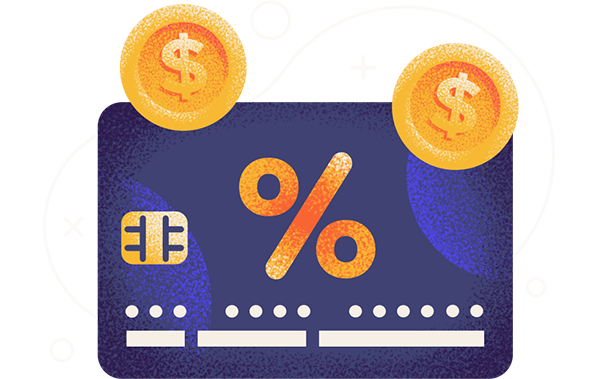Credit card interest is charged daily when you carry a balance from month to month, and it applies to both your existing balance and any new purchases posted to your account. The interest you’re charged one day also becomes part of the balance accruing interest the next.
Key Things to Know About Credit Card Interest
- Credit cards have higher interest rates than most loans, and interest compounds daily. That is why credit card debt is so expensive.
- You can avoid credit card interest charges by paying your bill in full every month.
- Most credit card companies give you an interest-free grace period from when your monthly statement gets generated to your due date.
- You can use WalletHub’s credit card interest calculator to see how much credit card debt is costing you and how much you could save with a better card.
Best Low Interest Credit Cards
What Is Credit Card Interest?
Credit card interest is money that you’re charged for the privilege of borrowing using a credit card. It usually applies only when you don’t pay your statement balance in full by your due date.
Since credit card companies will let you borrow for an indefinite period of time as long as you make at least a minimum monthly payment, they charge interest as payment for that service, at an interest rate that’s listed on your monthly statement and your credit card agreement.
Credit Card Interest vs. APR
Credit card interest specifically refers to the amount of money you pay when you carry a balance from month to month. A credit card APR, which stands for “annual percentage rate,” is simply the rate at which you accrue that interest over the course of a year. APRs are always expressed as a percentage.
The words interest rate and APR are used pretty interchangeably when it comes to credit cards. The only real difference is that the APR specifically refers to the interest rate over a year’s time, whereas interest actually accrues at a daily rate, which you can get by dividing the APR by 365.
Credit cards also have separate APRs for things like balance transfers and cash advances, as well as penalty APRs for late payments. Some cards even have low introductory APRs for a certain number of months on purchases and/or balance transfers.
You can learn more about credit card interest rates/APRs here on WalletHub.
How to Calculate Credit Card Interest
To calculate a credit card’s interest rate, just divide the APR by 365 (days in a year). Multiplying this rate by your average daily balance over the course of a billing period will tell you how much interest you’ll be charged every day when you carry a balance from month to month. Your average daily balance for a given billing period is the sum of each day’s balances, divided by the number of days in the billing period.
For example, if your APR is 15%, you’ll be charged interest on your outstanding balance at a daily rate of 0.041%. Your outstanding balance includes any unpaid interest that was previously assessed. In other words, a credit card’s interest rate applies not only to your principal balance, but also to the interest you were assessed yesterday, the day before that, etc.
You don’t have to crunch the numbers yourself, though – our free credit card interest calculator is here to help.
When Credit Card Interest Charges Apply
- When you don’t pay your full statement balance by the monthly due date. This leaves you with a “revolving balance” and will cause you to lose your grace period on new purchases until you pay in full for two consecutive billing periods.
- When you fail to make at least the minimum payment by your due date (which may trigger a penalty APR).
- When you take out a cash advance. There is no grace period on cash advances, and the APR is usually higher than your card’s regular APR.
- When you have a balance remaining after a card’s 0% introductory APR
- When you transfer a balance to a card with a 0% balance transfer promotion and use that same card to make purchases. You may lose your grace period on purchases and have to pay interest if the 0% promotion doesn’t apply to purchases too.
In summary, credit card companies will charge you interest when you carry a balance from month to month. Most give you a no-interest grace period of around 25 days, from the date your bill becomes available to when you need to submit payment.
Credit card interest charges don’t apply as long as you pay in full every month, avoid cash advances, and get your balance to $0 by the end of any introductory 0% APR periods.
Why You Might Get Charged Interest with No Balance
It’s understandably confusing to get a credit card bill that includes interest charges after bringing your account balance to zero. In some cases, it might end up being a mistake on the credit card company’s part. But it’s most often a simple case of misunderstanding the credit card billing process.
So let’s try to set the record straight, starting with a practical example.
Say you didn’t pay your last monthly bill in full and owe $500 when your next month’s credit card statement becomes available on June 1. While you may have until June 30 to submit a payment before it’s considered late, interest will be assessed based on the average daily balance in the interim. That means the amount you owe will increase with each passing day.
So even if you pay off the full $500 balance by the due date (June 30 in this example), you’ll still owe money for the interest charged daily since June 1. As a result, when your new bill becomes available on July 1, your balance will be equal to the interest you racked up the previous month. If you do not pay this amount, you will incur interest on interest and will continue to do so until you have paid two consecutive bills in full, regaining your grace period.
What can you take away from this example?
- If you begin a billing period with a revolving balance, interest will accrue on a daily basis.
- Paying off your original balance won’t bring your total account balance to zero. You will be responsible for the interest that accrued from the time your bill was made available to when your payment arrived.
The perhaps confusing distinction between your original balance and the finance charges that accrue on top of it underscores the importance of carefully reviewing your monthly credit card statements. Doing so will enable you to spot unanticipated charges as well as raise questions about potential mistakes.
How Do Card Issuers Determine Interest Rates?
The interest rate you’ll receive when you open a new credit card account is a product of your credit score, disposable income and other financial factors. Credit cards for people with excellent credit tend to have far lower interest rates, on average, than those geared toward people with limited credit, for example.
Average Credit Card Interest Rate by Credit Score
| Credit Score | Average Interest Rate |
| Excellent Credit (750+) | 17.68% |
| Good Credit (700 – 749) | 23.93% |
| Fair Credit (640 – 699) | 27.48% |
| Bad Credit (Below 640) – Secured Cards | 22.43% |
| Bad Credit (Below 640) – Unsecured Cards | 31.96% |
Source: WalletHub’s Credit Card Landscape Report
In addition to dictating which tier of offers you qualify for, your overall credit standing will impact the particular rate you’ll get from a card that advertises a range of possible APRs. For instance, an application may list an APR of 10.99% to 20.99%. The strongest applicants will get rates on the low end of that spectrum, and vice versa.
It’s also important to note that credit card companies are able to raise and lower interest rates on existing accounts under certain circumstances:
- They can increase interest rates on new transactions at any time, as long as they give you at least 45 days’ notice.
- They can also freely raise rates on existing business credit card balances, though you must be at least 60 days delinquent for such an action to be taken with a general-consumer credit card.
- Interest rate decreases can occur at any time. They’re typically the result of a cardholder improving his or her credit score or entering into a debt management agreement.
Finally, most credit card interest rates are tied to some type of economic index, such as the Prime Rate. That’s what “(V)” next to an APR means. Changes to this rate can result in interest rates rising or falling across the board.
How to Avoid Credit Card Interest
There are a few things you can do to ensure that finance charges won’t show up on your credit card account. We’ll go through these strategies in detail below.
Pay your bill in full every month
Paying off what you charge to a credit card in full every month is the best way to avoid interest, obviously. If you never carry a balance beyond your due date, your purchases will always be covered by your credit card’s grace period and you won’t owe any interest.
Just make sure not to do any cash advances, as those are not considered purchases and they do not have a grace period.
Pay as soon as possible
Interest gets assessed daily, so waiting for your due date when you have a revolving balance will result in 30 days of new finance charges that you’re responsible for. So if you want to pay as little as possible in interest when carrying a balance, pay your bill the same day it becomes available.
Use a 0% credit card
Zero percent credit cards allow you to avoid interest on purchases or a balance transfer for a certain number of months after opening an account. You just have to make minimum monthly payments to keep your 0% intro APR. And you should pay off most, if not all, of what you owe before your card’s high regular APR takes effect.
In most cases, regular interest rates will apply to whatever balance remains at the end of the 0% intro period. But when stores offer 0% financing, it often includes something called “deferred interest.” That means if you fail to pay down your full balance by the end of the 0% term, regular rates will retroactively apply to your entire original purchase amount. Avoid deferred interest payment plans at all costs.
Use a credit card calculator
If you want to save money with a 0% credit card, you need a concrete plan for paying off your balance. WalletHub’s credit card calculator can help you figure out how much to pay each month and which card offers the best collection of rates and fees for your needs.
Use the Island Approach
Separating your ongoing purchases from your revolving debt will ensure that interest rates apply to the lowest possible amount. Given that you should be able to pay for everyday expenses like gas and groceries in full every month, isolating such expenses on one credit card will prevent the average daily balance on your card designated for debt from being unnecessarily high. This, in turn, will lower your overall interest charges.
Ask for a Lower Limit
If you continually spend more with a credit card than you can afford to pay back, you might want to consider asking the issuer for a lower limit to remove the temptation.
Bottom Line
Understanding how credit card companies calculate interest can be helpful. But it’s not required to know that debt can be bad for your finances. Interest is extremely expensive, for one thing. And it can quickly become unmanageable, causing you to miss payments and hurt your credit score.
In other words, keeping a budget, regularly reviewing your spending habits, and avoiding unnecessary debt are essential to responsible money management. And you’ll thank yourself later if you're successful.



WalletHub experts are widely quoted. Contact our media team to schedule an interview.